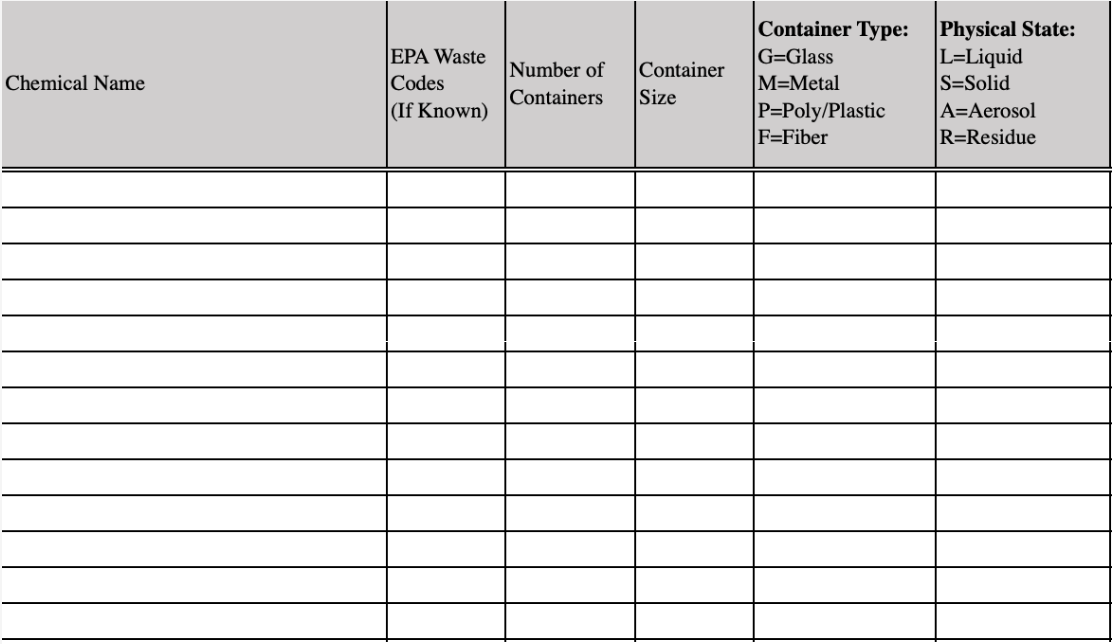If you use chemicals at your facility, you probably have some sort of chemical inventory system to track your emissions and material usage. If you use the right chemical inventory system, it will have an enormous impact on the rest of your business.
Environmental Marketing Services has an inventory template our clients use. This template allows clients to make a list of chemicals so that we can provide them a quote for lab-pack services. This template will also provide you a means of keeping a running list of your chemical waste inventory as it is generated. You will also find this significantly efficient should your facility get a surprise visit from the EPA. If you would like an excel copy of this template, contact Environmental Marketing Services today!
Why Chemical Waste Inventory is Important
If you have an inefficient chemical waste inventory system, it could cause significant problems for your facility. Problems that can result from poor chemical waste inventory include:
– Using chemicals that will put your permits at risk
– Complicating your Toxic Release Inventory reporting
– Ordering the wrong material
Tracking Chemical Waste Inventory Involves Accounting for Lab Managers
Lab managers find accounting to be one of the biggest challenges of their daily managerial responsibilities. They have to devise a plan of action, within a budget, how to fit the resources and needs of the lab. Accurate accounting will help to uncover any discrepancies between your actual chemical waste inventory and the perceived expenditures. Our template for tracking your chemical waste inventory could help with this process.
Tracking Chemical Waste Inventory Will Uncover Hidden Costs
If you have an inefficient chemical waste inventory system, it could be costing your laboratory valuable money and time. To understand how this could be affecting your lab take a look at the lifespan of one chemical in your lab from the time of purchase to the time of disposal to understand this reasoning.
The first cost of a chemical is when you make the initial purchase. If you have to order the material to meet an urgent deadline, you are probably charged additional fees. With a traditional purchase, the chemical has to be documented when it is delivered and then added to an inventory list by your designated employee. Additional funds and time are needed for following safety and compliance measures with the arrival of a new chemical, such as safety data sheets, special storage measures, and employee training.
While the chemical is in your facility, or what is called the ‘lifespan’ of the chemical, multiple lab employees will likely share its container. If the chemical is needed by two or more employees, or if the container is misplaced, it may result in the order of additional supplies. If you don’t plan ahead, you could end up with numerous amounts of the same chemical.
The end result of this process is that chemical stockpiles will end up costing your facility more for its unused bulk surplus. It is more cost-effective to order ‘just in time’, or ‘as needed’ rather than having too much on hand. This method of ordering ‘when needed’ will also eliminate the safety and compliance risks of having too many chemicals on-site as well as cut down on the costs of sending unused containers to your chemical waste facility.
Having excess chemicals in your lab can create a host of hidden costs. A lot of chemicals are regulated under the law as to how much volume you can store, and if you exceed this amount there are substantial fines. Another danger in storing excess chemicals creates an increased risk of spills and workplace injuries. An additional cost is the use of precious lab storage space especially if they require special storage arrangements.
During every step of a chemical’s life span, it accumulates hidden costs from funds and over time. Without a proper chemical waste inventory, your lab could easily get side-tracked with more urgent tasks and forget about tracking all your chemicals. Talk to the experts at Environmental Marketing Solutions about an effective method for tracking your chemical waste inventory.
Tracking Chemical Waste Inventory
A lot of laboratories keep chemical waste inventory on a piece of paper that is tucked away in a cabinet or a binder on some shelf. Others use a digital spreadsheet or keep it listed on the lab manager’s desktop computer. The list appears when there are new chemicals to add or if a spill or other accident occurs to record safety information. For many labs, this chemical waste inventory recording sees little other uses.
Your lab should not allow for your chemical waste inventory data to take a back-seat in your management of chemicals. If your facility uses chemicals in your daily tasks, then this chemical waste inventory list should be kept relevant minute by minute. As your quantities shrink, and chemicals approach their expiration date, this data should all be current to the time of day. Ordering or reordering should not be done after a chemical is depleted or expired. Environmental Marketing Services can help you create a system for a more up-to-date and safer way to track your chemical waste inventory.
Who to Contact About Tracking Your Chemical Waste Inventory
Environmental Marketing Services has more than ninety years of experience in handling recycling and waste disposal needs. We are here to help your facility minimize liability in dealing with hazardous waste materials and protect the environment. If you have questions on how to track your chemical waste inventory, talk to one of our experts on how to use our inventory template and create an effective and safe method of tracking for your facility.



